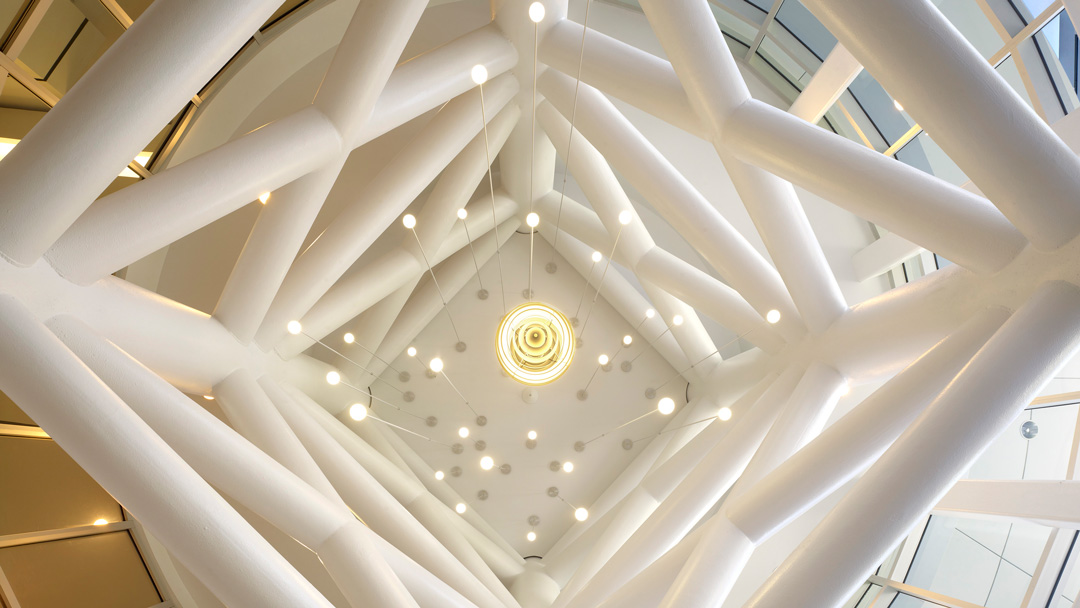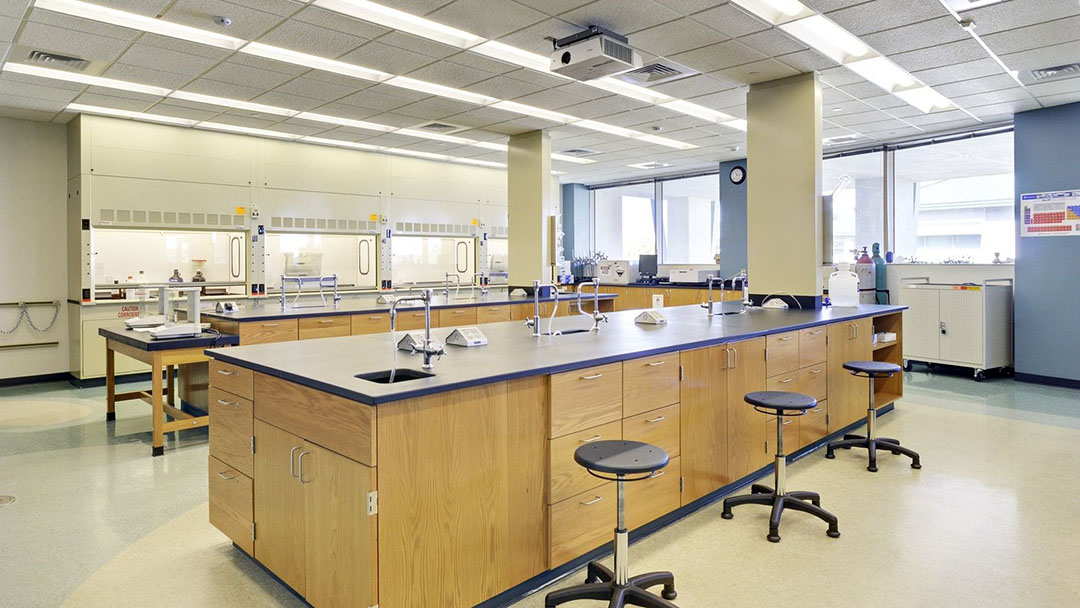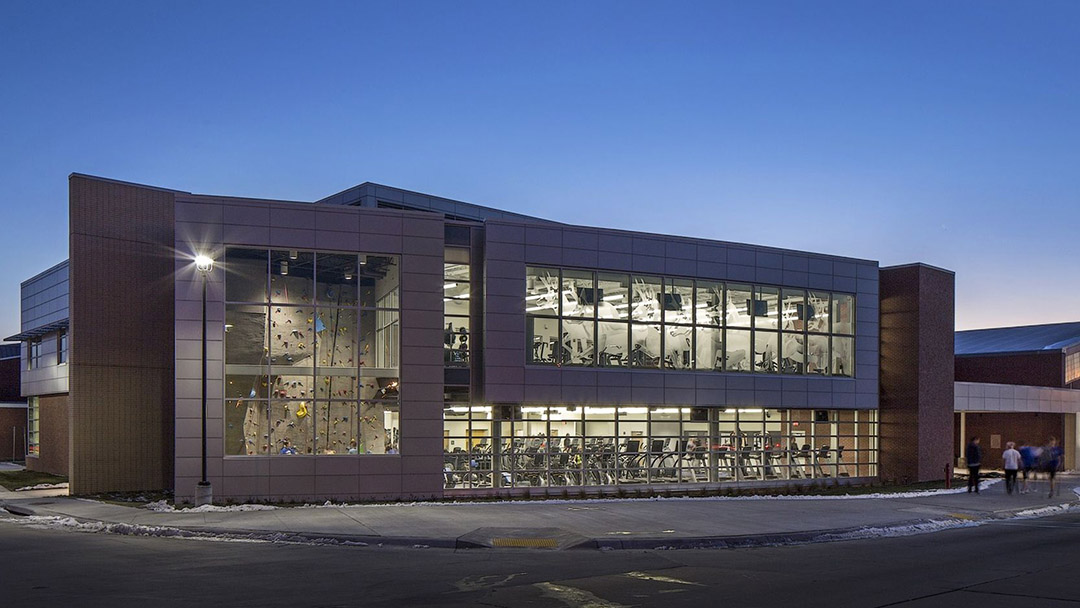The Louis Armstrong New Orleans International Airport (MSY) receives top award for Best Airport in North America for third consecutive year.
Lighting and Sustainability Facilitate ‘Doing Good’ at Thurgood Marshall Hall
Recent Articles
Lighting and Sustainability Facilitate ‘Doing Good’ at Thurgood Marshall Hall
Design focusing on daylighting and wellbeing benefits students, faculty and the University of Maryland School of Public Policy’s Do Good Institute
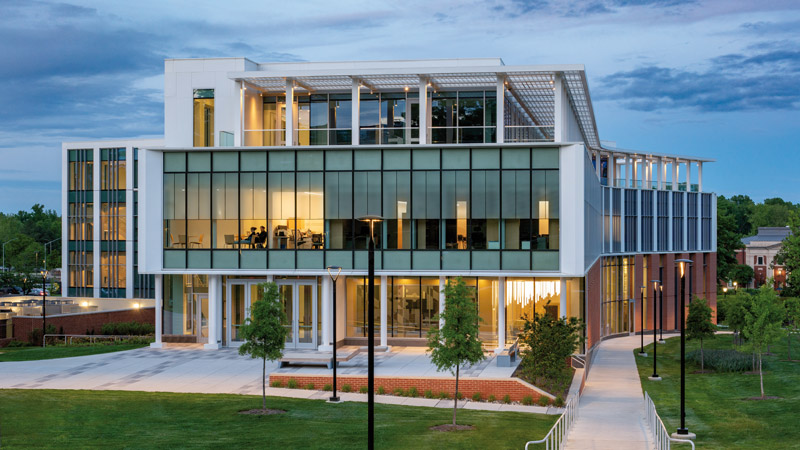
Thurgood Marshall Hall, home to the School of Public Policy at the University of Maryland, stands at the heart of a new entrance to campus as a highly visible symbol of the university’s dedication to serving the public good. A magnet for public discourse and a hub for social innovation and nonprofit leadership, the four-story building brings together more than 90 faculty members and 1,000 students formerly dispersed across four separate facilities. It also houses the Do Good Institute, a not-for-profit incubator that’s the physical manifestation of the University’s mission to become “the nation’s first Do Good Campus.”
Our design team incorporated a wide variety of sustainability features into this LEED® Gold building, and wellness was a special focus. Every office and collaboration space has direct access to daylight, including those spaces that are located partially underground because of the unique grade of the site. Natural light is also incorporated into the design of the auditorium as a key feature, distinguishing the space from every other large, windowless lecture hall on campus.
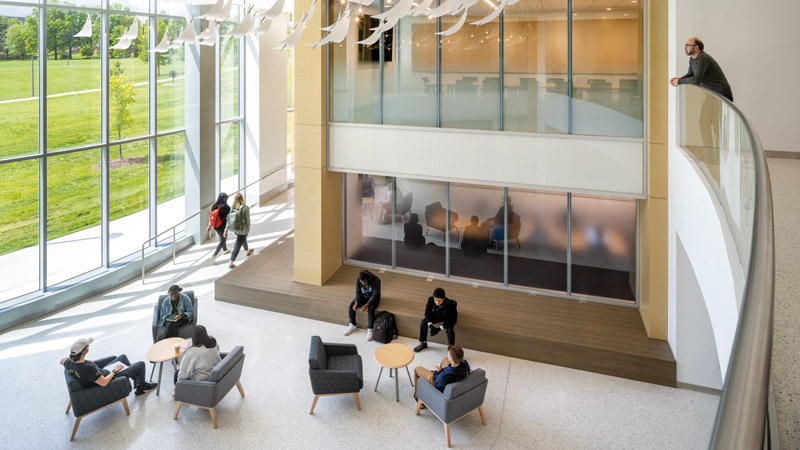
A unique shading system for the East and West building façades ensures custom inner window pane shading based on exact building location and orientation. This ensures a maintenance-free, energy efficient, high-performing building envelope. Private faculty spaces are provided with operable shading systems for adjustment and automated systems in public areas automatically adjust throughout the day for optimal comfort.
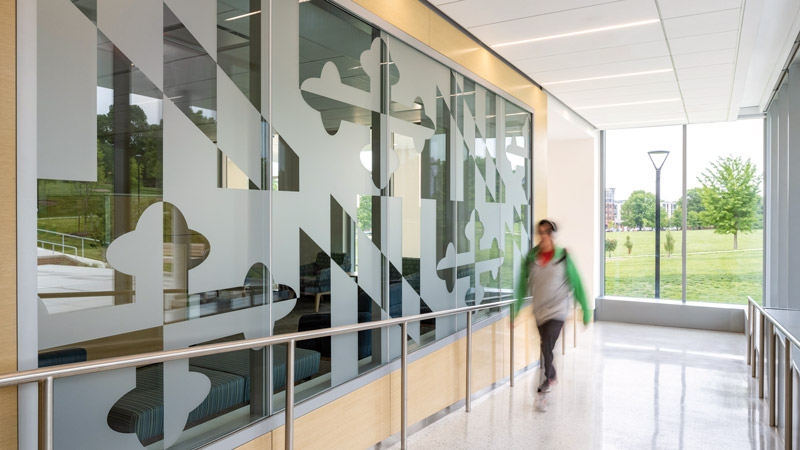
A recent post-occupancy study validated the effectiveness of this design. Professors, staff and students reported high levels of satisfaction with the environment, ventilation, temperature and other key measures. The views, the quality of light and ventilation all rated highly for employees and instructors. And respondents particularly enjoy the rooftop terrace, an open natural space that houses events that is connected to the library space with an operable exterior wall partition that ensures seamless indoor-outdoor connectivity.
Thurgood Marshall Hall is already serving as a magnet for scholars, practitioners and experts from campus, the State of Maryland and around the world, as they gather to teach, to learn and to lead public policy in the 21st century.
Global Architecture & Design Award bestowed to LEO A DALY
Recent Articles
New Orleans Airport Named Best Airport in North America Three Years in a Row
Adaptive Reuse Saves Embodied Carbon at Repositioned 20 Mass
Our integrated design team excels in complex adaptive reuse projects. The process of redesigning a building to support a new function utilizes our structural engineers, our systems experts, our architects and more. Our teams’ deep knowledge allows them to tackle even the most complex projects. These adaptive reuse projects create far less embodied carbon compared to demolishing and constructing a new building.
International Hotel & Property Awards Shortlist 20 Mass Royal Sonesta
LEO A DALY-Designed Royal Sonesta Capitol Hill at 20 Mass is shortlisted for the 2024 International Hotel & Property Awards.
Forbes Travel Guide Picks Two LEO A DALY Projects for 2024 Lists
Two hotels with major LEO A DALY design work have been ranked highly by Forbes Travel Guide.
Housing for Veterans Created in Tunnel to Towers Partnership
Tunnel to Towers partners with LEO A DALY to create housing for Veterans experiencing homelessness through projects in Florida and Georgia.
Global Architecture & Design Award bestowed to LEO A DALY
Thurgood Marshall Hall earns design excellence and innovation award
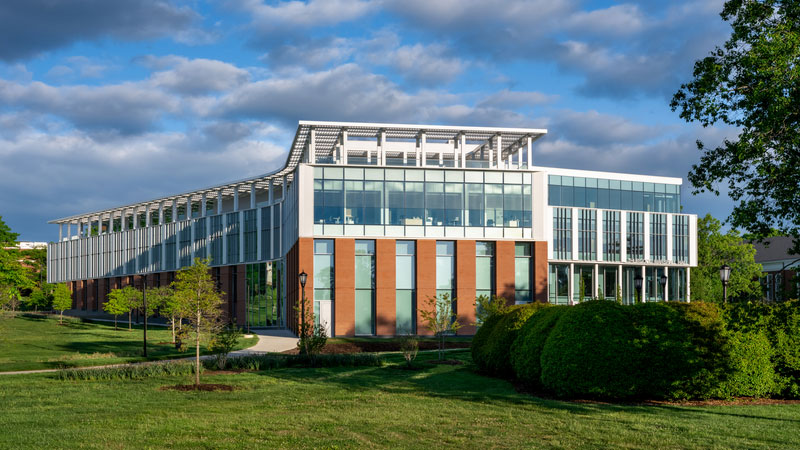
“Working with the University of Maryland to create this state-of-the-art environment for public policy education and the world’s first Do Good Institute has been an incredible journey and achievement for all involved,” celebrated Principal-in-Charge Rauzia Ally. “We are extremely honored and proud to be recognized for the powerful democratic design of Thurgood Marshall Hall.”
Out of thousands of submissions from more than 45 countries, LEO A DALY’s Thurgood Marshall Hall earns outstanding built project in the Institutional category of the Global Architecture & Design Awards 2023 (GADA). Spanning architecture, landscaping, urban and interior design, selected entries are carefully evaluated by an international jury panel composed of established scholars, esteemed professionals, prominent press members, creative design professionals, and experienced entrepreneurs.
As a building dedicated to democratic thought, visibility and transparency were metaphors necessary to infuse into the design. “These ideals became organizing principles from every element of the interior program and exterior expression,” shared Global Design Principal Irena Savakova. “Activity and discourse are on display everywhere in the building and we integrated sound privacy without interrupting visual connectivity.”
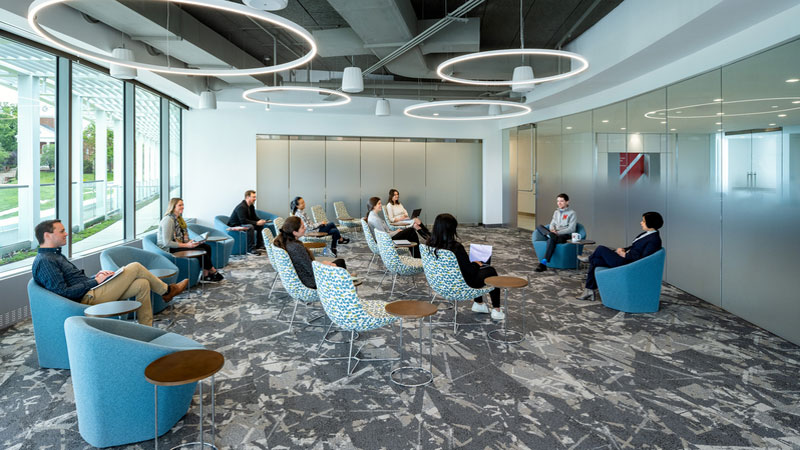
The jewel piece of the design concept is the deliberative chamber, an oval-shaped learning environment created for United Nations-style debate. The chamber was formally identified as a signature organizing element of the program, and as such it is placed as a floating, sculptural element within the transparent glass box of the East building entry. In this way, it becomes an object of curiosity and inspiration that can gather attention from all arrival pathways and energize the Gateway Plaza of the College Park university campus.
The high-performance design of Thurgood Marshall Hall includes a targeted, customized solar strategy. Location specific encapsulated translucent fins and shading trellises coincide with the solar cycle, maximizing sunlight, framing unique views and minimizing energy use.
Rethinking the Future (RTF) established GADA in 2012 with the aim to sustainably advance the built environment and to connect and inspire the next generation across the globe.
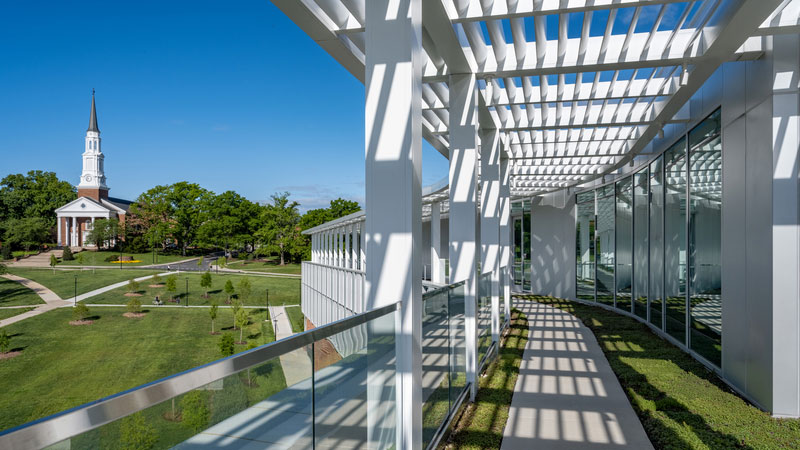
Winnebago Child Care Center
Winnebago Child Care Center
The Winnebago Tribe of Nebraska’s urgent effort to preserve its stories, language and traditions across generations lies at the heart of this child-care center. The design serves as a scaffold for storytelling, creating layers of meaning out of its parti, site relationship, geometry, organization, materials, patterns and colors. Its program of educational, play and dwelling spaces serves the wellness and developmental needs of the whole family.
Ho-Chunk stories infuse the design in abstract form, teaching history. A hub-and-spoke parti embodies the Thunderhawk, conveying strength and protection. Program spaces extend from a central Rotunda whose shape recalls a traditional Ciporoke dwelling. Louvered, 360-degree clerestory windows cast dynamic shadows in patterns recalling Ho-Chunk basket-weaving. East-west circulation honors the tribe’s sun-centered creation story.
Three wings extend from the rotunda, their rectangular forms embodying the Longhouse. To the southwest, the daycare wing engages children at each developmental level, including special needs. Outdoor play equipment follows the existing topography, naturally separating age groups. The east wing offers career training for adults. The northern wing lodges the children of overnight workers. Adjacent, a row of tiny houses facilitates transitional living for young adults.
Client
Winnebago Tribe of Nebraska
At a glance
30,000 SF
Features
Designed to reflect Ho-Chunk culture, the center incorporates abstract depictions of tales, creating captivating spaces. The hub-and-spoke parti represents strength and protection, while the central Rotunda reflects the traditional dwelling, nurturing educational and play areas.
Services
Programming
Architectural
Mechanical
Electrical engineering
Fire Protection
Plumbing
Civil Engineering
Interior Design
Construction Administration
Mercer University, Spearman C. Godsey, Science & Research Center
Mercer University, Spearman C. Godsey, Science & Research Center
The $44 million, 143,410-SF Spearman C. Godsey Science Center gives undergraduates at Mercer University access to 60+ state-of-the-art teaching and research labs, accommodating a growing enrollment and research activity in chemistry, biology, and neurosciences.
The Patterson Building was demolished to make room for the signature structure, which now anchors a science quadrangle incorporating School of Medicine and School of Engineering facilities and Willet Science Center.
Designed by LEO A DALY and Hussey Gay Bell, the science building gives undergraduates at Mercer unprecedented access to graduate-level research facilities. Aside from general biology and chemistry labs, the center includes specialized teaching labs in soil and field biology, anatomy and physiology, infectious diseases, molecular and cellular biology, organic chemistry, problems in chemistry and biochemistry.
Additional specialized labs housing instrumentation and a nuclear magnetic resonance spectrometer, as well as a laser lab, computational center, growth room, cold room and tissue culture suite are included in the facility. Lab space is also devoted to science courses offered through Penfield College and Tift College of Education.
The designers used an inclusive planning process based on PKAL principles to maximize collaboration in the design process and increase opportunities for multidisciplinary learning in the finished product. The planning process identified core adjacencies, efficiencies, and opportunities for collaboration in the new building, and arranged them to maximize chance encounters between students and faculty of different research disciplines.
The program is laid out in two wings that come together in the corner commons space. The commons space is located in a prominent corner of the site, forming a gateway to the new STEM quad created by Spearman S. Godsey Science Center and the existing engineering buildings. The commons space serves as an informal gathering space in the building, it is populated with “coffee house” style seating to encourage small group collaborations and study. One of the corridors is intentionally oversized, allowing students to spill into the building wings and engage in for breakout sessions outside lecture halls, teaching labs and the research labs on the upper floors.
Client
Mercer University
At a glance
- 143, 410-SF
Features
- 60+ State-of-the-Art Labs
- 10,465 SF of Research Space
- 7 Lecture Halls
- 46 Offices
- 3,000 SF of Shell Space for Growth
- 89 Fume Hoods
- 880 Tons of Air Conditioning
- 12.5 miles of Plumbing Pipe
Services
- Master Planning
- Programming
- Architectural Design
- Interior Design
- Mechanical Engineering
- Electrical Engineering
- Structural Engineering
- Construction administration services
University of Nebraska Medical Center, Administration and Laboratory Building
University of Nebraska Medical Center, Administration and Laboratory Building
Serving the University of Nebraska Medical Center, this new “innovation hub” this new 350,000 SF administration and laboratory building will anchor the new mixed-use, urban development.
Stretching multiple floors, the laboratory and office building will provide a work environment reflective of both hybrid and in-office working models. With growth of the University’s research enterprise demand for additional research space will be resolved through this project, though the optimal stacking and work flows within the labs and between labs to preserve key credentiality and safety boundaries, were the organizing drivers which led to the new building design. The project includes:
- Mapping workflows and critical adjacencies with considering lab certifications and accreditations sought to be maintained or integrated.
- 24,121 SF of Finished Dry Lab Space (3rd Floor)
- 48,242 of Unfinished Lab Shell Space (4th & 5th Floor)
- 24,121 SF of Finished Wet Lab Space (6th Floor)
- 13,136 SF of Admin Office Space (2nd floor) with 11,000 SF of Unfinished UNMC
- Admin Office Shell Space (on 1st & 2nd Floor)
- Loading Dock & Service Yard
Client
University of Nebraska Medical Center
At a glance
180,870 Gross Square Feet
Features
Finished Dry & Wet Laboratories
Unfinished Laboratory Shell Space
Administrative Offices
Administration Office Shell Space
Parking Garage
Services
Project Management
Architecture
Laboratory Planning
Mechanical Engineering
Electrical Engineering
Structural Engineering
Fire Protection Engineering
Interior Design
CHI Health, Creighton University Medical Center at Bergan Campus, School of Medicine
CHI Health, Creighton University Medical Center at Bergan Campus, School of Medicine
The new CHI Health Creighton University Medical Center Bergan Mercy merges Creighton University Medical Center with CHI Health Bergan Mercy Medical Center. Together they form a contemporary, leading academic health system including an ambulatory clinic, medical school, teaching hospital and Level-I trauma center.
Unifying two cultures through design
Recognizing the challenges presented from the operational and cultural differences between the academic side and the private healthcare side of the merger, we developed solutions that allowed them to coalesce into a single academic health system. We maximized flexibility of the design by including touch-down spaces that are available for medical teams and teams of residents to use as needed. This makes maximum use of the space and ultimately produces a more efficient design. Doctors and residents also work out of shared office spaces, encouraging collaboration and access to faculty.
Converting medical office building into school of medicine
Floors two through six of a medical office building were fully renovated to house Creighton University School of Medicine’s academic and administrative space. A mix of collaborative spaces and cutting-edge care environments allows physicians to grow in their specialties by working with others, while students learn clinical techniques from the very best. Patients also benefit from a modern, wellness-focused approach to care.
The clinic building is designed to foster care by inter-professional teams. It features eight pods of 17 rooms, each arranged around a centralized work area. Patients enter from a public-facing hallway that’s intended to be less busy than those in many clinics. Staff enters through the back from the work areas, where students, residents and staff can consult on cases outside the earshot of patients.
Incorporating the medical school into the private facility also required creating room for students in patient areas – space for collaboration and learning in a real-life setting. The new ICU rooms are much larger than those at the pre-renovation Bergan or Creighton University Medical Center in order to accommodate not only family members and the extra technology and equipment in use today, but also the groups of medical students, residents and others making rounds as part of the hospital’s new teaching role.
Client
CHI Health, Creighton University
At a glance
Five floors
25 resident/fellow on-call rooms
Eight faculty on-call rooms
15 student on-call rooms
Resident lounges
Student lounge
Features
Floors two-six of medical office building renovated for school of medicine
Touch-down spaces for medical and resident teams
Doctors and residents work in collaborative spaces
Many spaces enlarged to make room for residents and doctors
Services
Medical planning
Architectural design
Structural design
Civil engineering
Anoka-Ramsey Community College, School of Nursing
Anoka-Ramsey Community College, School of Nursing
Home to the largest program on campus; nursing, as well as the business program and general-purpose classrooms, this 1970s, multi-discipline academic building had maxed out capacity within their existing space. Given the melting pot of student activity, the design evolved with the input of students and faculty to include more than just classrooms, but robust social spaces throughout the building that included open and accessible faculty offices and a commons that extended learning to the outdoors with new terrace. Some of the program elements included:
Active Learning Environments: Created collaborative classroom environments, establishing more flexible and hands-on learning spaces that provide the entire campus community with flexible learning and gathering spaces, maximizing every square foot of the building, and worked to eliminate MN State standard variances and achieve performance and program needs.
Simulation Suite: Provides dedicated control and observation/debrief spaces that increase learning flexibility and student exposure to needed simulation time in supplement to clinical hours.
Open Labs: Created dedicated spaces for individual student hands-on simulated spaces reflective of real-world experiences to close workforce experience gap.
Skills Labs: Were carefully configured with equipment placement, student flow, and realism where appropriate to mimic how students might encounter their first days as a licensed practitioner.
Engineering Infrastructure Upgrades: Replaced and modernized mechanical, electrical, fire and life safety, and A/V infrastructure, improving building and teaching efficiencies and user comfort throughout.
Client
Anoka-Ramsey Community College
At a glance
- 31,150-SF
Features
- Simulation Suite
- Open Labs
- Skills Labs
- Active Learning Environments
- Met & Exceeded SB2030 Energy Goals
Services
- Architectural Design
- Interior Design
- Mechanical Engineering
- Electrical Engineering
- Structural Engineering
- Construction administration services
University of California, Merced, Engineering and Science Building
University of California, Merced, Engineering and Science Building
As the first of three new engineering and natural science buildings on campus, this new engineering and classroom building was designed with the “Complete Engineer” in mind.
As you enter the first floor you are immersed in student-driven spaces that are supported by a central corridor that opens directly to the exterior and concentrates activity within the outdoor living room. From there you are greeted with a glass–enclosed stair that leads to an active program of engineering education and collaboration that spills out of the classrooms and into the central corridor, fostering casual cross-disciplinary interaction of students and faculty. This vertical connection continues at several points along its length, allowing for greater connectivity between floors and provide light-filled gathering spaces on each floor. As you explore deeper into the research building, interactive learning environments welcome all users, creating an academic hub that includes computer labs, a machine shop, general and lab classrooms, collaborative and quiet spaces, and a vivarium.
The L-shaped building defines two sides of the outdoor living space with a grand, three-story passageway that welcomes students entering from the main campus pathways while framing views to the campus. Its glass sunshades overlay the structure and provide an outdoor space that is several degrees cooler than in the sunlight. Once mature, trees will form a dense canopy over the outdoor living space providing further shade, encouraging student collaboration beyond the walls of learning.
Client
University of California, Merced
At a glance
- Four-Stories
- 166,00 SF
Features
- Wet and dry lab spaces for student and faculty research
- Enclosed lab support zones for researchers
- Functional support spaces (faculty offices, lab personnel offices, administrative areas, TA offices)
- 24 classroom labs
- Computer labs
- Machine shop
- Vivarium
- Scholarly activity rooms
Services
- Project Management
- Architectural Design
- Construction Documents,
- Contract Administration
Florida Atlantic University, Engineering & Computer Science Building
Florida Atlantic University, Engineering & Computer Science Building
As an internationally recognized University for cutting edge research and education in the areas of computer science and artificial intelligence (AI), computer engineering, electrical engineering, bioengineering, civil, environmental and geomatics engineering, mechanical engineering, and ocean engineering, the Florida Atlantic University needed to expand its research laboratory and learning spaces where students could gain the knowledge to design tomorrow’s innovative, nimble and intelligent processes. The new 97,000-square-foot, five-story facility includes state-of-the-art hands-on teaching labs, classrooms, as well as a visualized cloud computing infrastructure, enabling the use of information technology resources on demand.
Focusing on the Students and Processes: Upon arriving in the lobby, students and users are submerged with interactive learning on displays. Systems such as temperature, water flows, energy usage, and pressure valves are celebrated, showcasing real-time usage of the building, creating an interactive tool that changes the way engineering is taught. As the student travels deeper within the building they are immersed with engineering education and collaboration spaces that spill out of the classrooms and into the central commons, exposing the engineering design process to students of other disciplines utilizing the wide range of classrooms.
Student Driven Spaces: As you travel vertically through the building, programming elements strengthen cross-disciplinary environments that bring students and faculty together in unexpected ways and change the way engineering is taught. Student-driven project spaces feature computer engineering spaces, computer build/circuitry labs, electronic engineering research labs, bio informatics labs, general classrooms, open and collaborative user spaces, individual focus spaces, and problem-solving rooms for more concentrated, undisturbed learning.
LEED Platinum Design: Since science buildings are typically energy-consuming by nature, the University and our project team wanted to build a facility that would showcase the University’s commitment to sustainability. Some of the green elements included chilled beam technology, temperature and lighting control systems, solar hot water system, elevation features designed to increase energy efficiency, north facing skylights for diffused lighting in computer science labs and offices, and a green roof.
Client
Florida Atlantic University
At a glance
96,000 SF
LEED Platinum certification
Features
- Interactive Learning-On-Display
- Computer Engineering Labs
- Electronic Engineering Research Labs
- Bio Informatics Labs
- General Classrooms
- Electronic library
Services
- Architecture
- Engineering
- Interior Design
- Construction Administration


